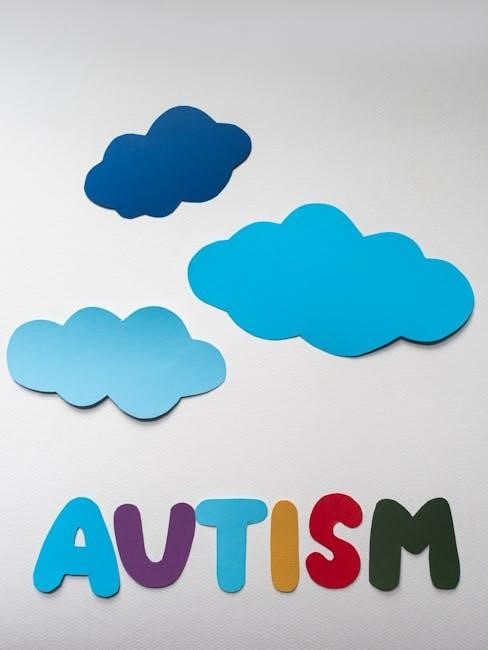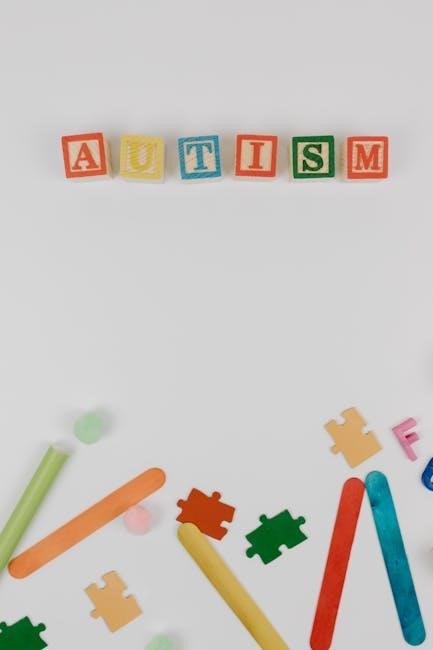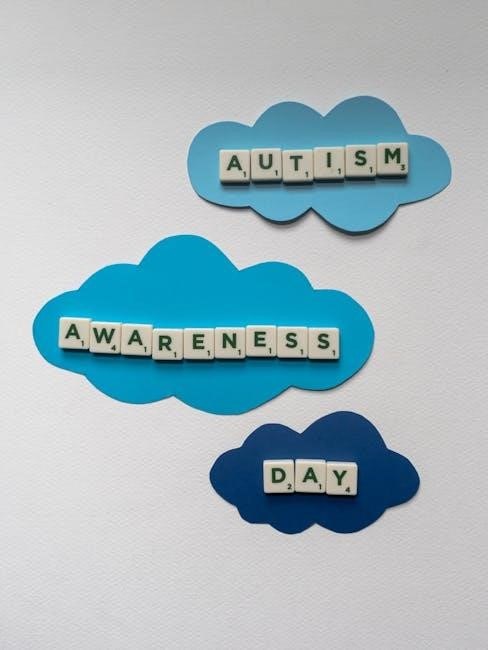Speech Therapy Autism Activities PDF: Comprehensive Guide
This comprehensive guide provides essential speech therapy autism activities in downloadable PDF formats‚ offering structured and engaging resources for improving communication and social skills in autistic individuals.
Speech therapy for autism focuses on improving communication skills‚ addressing challenges such as verbal and non-verbal language‚ social interactions‚ and speech clarity. It is a cornerstone of support for individuals with Autism Spectrum Disorder (ASD)‚ helping them express needs‚ wants‚ and ideas effectively. Certified speech-language pathologists (SLPs) design personalized programs tailored to each child’s unique abilities and goals. Therapy often incorporates playful‚ engaging activities like role-playing‚ storytelling‚ and sensory integration to foster a positive learning environment. Early intervention is critical‚ as it lays the foundation for lifelong communication growth. Parents and caregivers play a vital role in reinforcing these skills at home‚ creating a cohesive support system for the child’s development. Structured activities from speech therapy autism activities PDF resources can further enhance progress‚ offering practical tools for consistent practice.
Understanding the Importance of Speech Therapy in Autism
Speech therapy is a critical intervention for individuals with autism‚ addressing communication challenges that impact social interactions and daily life. It helps develop verbal and non-verbal skills‚ such as speech clarity‚ language comprehension‚ and emotional expression. Early intervention is key‚ as it can significantly improve long-term outcomes. Speech therapy also fosters independence‚ confidence‚ and the ability to form meaningful relationships. For many autistic individuals‚ it bridges the gap between isolation and active participation in their communities. By tailoring activities to individual needs‚ speech therapy creates a supportive environment for growth‚ empowering individuals to navigate a world that often relies heavily on effective communication. Consistent practice‚ supported by structured resources like speech therapy autism activities PDF‚ further enhances progress and overall quality of life.
Benefits of Structured Speech Therapy Activities
Structured speech therapy activities provide consistency and predictability‚ which are crucial for autistic individuals. These activities enhance engagement by using visual aids‚ interactive storytelling‚ and sensory play‚ making learning more effective. They also offer measurable progress‚ allowing therapists and parents to track improvements in communication skills. By focusing on specific goals‚ structured activities help build confidence and independence in expressing thoughts and emotions. Additionally‚ these activities can be personalized to align with individual interests and abilities‚ ensuring a more tailored and impactful experience. Regular use of structured resources‚ such as speech therapy autism activities PDF‚ fosters a supportive learning environment and empowers parents to actively contribute to their child’s communication development.

Core Speech Therapy Activities for Autism
These proven‚ effective speech therapy activities are designed to enhance communication and social interaction in autistic individuals‚ offering evidence-based strategies for meaningful progress.
Sorting Objects into Categories with Picture Prompts
Sorting objects into categories using picture prompts is a highly effective speech therapy activity for autistic individuals. This activity enhances categorization skills‚ improving communication and problem-solving abilities. By organizing items into groups (e.g.‚ animals‚ vehicles‚ or food)‚ children develop foundational language concepts. Picture prompts provide visual support‚ making the task engaging and accessible. This activity also promotes focus‚ memory‚ and the ability to identify relationships between objects. Customizable to varying skill levels‚ it encourages independent thinking while building confidence in expressive and receptive language skills. The structured nature of this task makes it ideal for reinforcing speech therapy goals in a fun and interactive way.
Interactive Storytelling and Narrative Development
Interactive storytelling is a powerful tool in speech therapy for autism‚ fostering communication and social skills. By engaging children in shared narratives‚ this activity encourages active participation and creativity. Visual aids‚ such as pictures or props‚ enhance comprehension and retention. Children learn to sequence events‚ express thoughts‚ and understand perspectives. This method also builds confidence in using language to convey ideas. Storytelling activities can be tailored to individual interests‚ making them highly effective for diverse learning needs. Regular practice with interactive stories helps autistic children develop clearer and more coherent communication‚ laying a strong foundation for future language development and social interactions.
Role-Playing Games for Social Communication
Role-playing games are a key speech therapy activity for autism‚ fostering social communication and emotional intelligence. These games simulate real-life scenarios‚ helping children practice interactions‚ understand social cues‚ and develop turn-taking skills. By acting out different roles‚ autistic individuals can explore various perspectives and emotions‚ enhancing their ability to communicate effectively. Role-playing also encourages creative expression and problem-solving‚ making it engaging and effective. Tailored to individual interests and abilities‚ these activities provide a safe space for children to build confidence in social interactions. Regular practice with role-playing games can significantly improve a child’s ability to navigate everyday conversations and relationships‚ fostering meaningful connections and independence.
Sensory Play Integration for Enhanced Engagement
Sensory play is a powerful tool in speech therapy for autism‚ enhancing engagement and focus during sessions. By incorporating tactile‚ visual‚ and auditory elements‚ such as playdough‚ sand‚ or sensory bins‚ therapists create a calming and stimulating environment. This approach helps autistic children process information more effectively‚ reducing anxiety and increasing participation. Sensory activities can be paired with communication exercises‚ making learning more enjoyable and accessible. For example‚ using textured materials while practicing vocabulary or sequencing skills can improve retention and motivation. Tailored to individual sensory needs‚ these activities foster a deeper connection to the learning process‚ making speech therapy more impactful and enjoyable for children with autism.
Video Modeling Techniques for Speech Development
Video modeling is a highly effective method in speech therapy for autism‚ leveraging visual learning to enhance communication skills. By watching videos of peers or models engaging in conversations or demonstrating speech‚ autistic children can mimic and learn new skills. This technique is particularly beneficial for visual learners‚ as it provides clear‚ repetitive examples of language in use. Videos can be tailored to address specific goals‚ such as initiating conversations or using complex sentences. Many resources‚ including downloadable PDFs and digital tools‚ offer pre-made video models or guides for creating custom content. This approach not only engages children but also allows for consistent practice in both clinical and home settings‚ promoting progress in speech development.

Downloadable PDF Resources
Access a wide range of free and paid PDF resources designed for speech therapy autism activities. These include editable‚ fillable‚ and printable materials to support personalized learning and therapy sessions.
Free and Paid PDF Worksheets for Speech Therapy
Discover a variety of free and paid PDF worksheets tailored for speech therapy autism activities. These resources include interactive exercises‚ vocabulary building‚ and social communication tasks. Free options are ideal for therapists and parents seeking budget-friendly tools‚ while paid resources offer more detailed and specialized materials. Many PDFs are editable‚ allowing customization to meet individual needs. Activities range from sorting games to role-playing scenarios‚ designed to enhance language skills and engagement. These worksheets are perfect for both clinical and home-based therapy sessions‚ providing structured yet flexible support for children with autism. They are easily downloadable and printable‚ making them a convenient addition to any speech therapy program.
Editable and Fillable PDFs for Personalized Sessions
Editable and fillable PDFs offer a versatile way to create personalized speech therapy sessions for autistic individuals. These resources allow therapists and parents to input client-specific details‚ ensuring activities align with individual goals and interests. Many PDFs are designed for digital use‚ enabling easy modifications and updates. They also support progress tracking‚ making it simpler to monitor improvements over time. With customizable templates‚ these tools enhance engagement and adaptability‚ catering to diverse learning styles and abilities. Fillable PDFs are particularly useful for creating tailored worksheets‚ communication boards‚ and interactive exercises. Their flexibility ensures that therapy remains dynamic and effective‚ providing meaningful support for children with autism in both clinical and home settings.
Boom Cards Companion for Digital Learning
Boom Cards offer a dynamic and interactive digital learning experience‚ perfectly complementing speech therapy autism activities PDFs. These digital flashcards and activities are designed to engage children with autism‚ providing auditory‚ visual‚ and tactile prompts to enhance speech and language development. Many PDF resources include a Boom Cards companion‚ allowing seamless integration into digital devices like tablets. This format supports remote learning and home-based therapy‚ making it accessible for parents and therapists alike. Interactive elements such as matching games‚ sequencing tasks‚ and storytelling exercises encourage active participation. Boom Cards also provide immediate feedback‚ helping children track their progress and stay motivated. This innovative tool bridges traditional and digital learning‚ offering a flexible and engaging way to support communication skills in autistic individuals;

Therapeutic Approaches
Pivotal Response Treatment (PRT)‚ the Attention Autism Method‚ and visual aids are key approaches in speech therapy for autism‚ fostering natural communication and engagement through structured‚ child-centered activities.
Pivotal Response Treatment (PRT) Overview
Pivotal Response Treatment (PRT) is a widely recognized‚ evidence-based approach in speech therapy for autism‚ focusing on pivotal areas like communication‚ social interaction‚ and emotional regulation. It emphasizes child-led interactions‚ using natural reinforcers to increase motivation and engagement. PRT is effective in improving verbal and non-verbal communication by targeting foundational skills that impact broader developmental areas. By involving parents and caregivers in therapy‚ PRT fosters consistency and generalization of skills across environments. Its flexibility and adaptability make it a valuable tool for tailoring interventions to individual needs‚ ensuring meaningful progress in speech and language development for autistic children.
Attention Autism Method by Gina Davies
The Attention Autism method‚ developed by Gina Davies‚ is a highly effective approach for supporting individuals with autism‚ focusing on developing attention‚ communication‚ and social skills. This structured yet flexible method uses visually engaging and motivating activities to capture and maintain attention‚ fostering spontaneous communication. It emphasizes the importance of creating a positive learning environment where children feel secure and motivated to engage. By incorporating elements of play and interest-based activities‚ the Attention Autism approach encourages natural interaction and language development. Parents and therapists can apply this method to create tailored sessions‚ aligning with individual needs and promoting meaningful progress in communication abilities.
Using Visual Aids in Therapy Sessions
Visual aids are a cornerstone of effective speech therapy for autistic individuals‚ helping to clarify communication and reduce anxiety. Tools like picture communication symbols‚ visual schedules‚ and interactive activities provide structure and clarity. These aids enable children to process information more effectively‚ fostering better engagement and focus during therapy sessions. For example‚ using visual timers can help manage transitions‚ while picture prompts can support vocabulary development. Incorporating visual aids into therapy sessions creates a predictable and reassuring environment‚ allowing individuals to concentrate on learning and practicing communication skills. This approach aligns with many autism-friendly therapeutic methods‚ enhancing the overall effectiveness of speech therapy interventions.

Home Support and Parental Involvement
Parents play a vital role in supporting speech therapy by incorporating activities at home‚ aligning with therapist goals‚ and fostering a nurturing environment for communication growth.

How Parents Can Supplement Speech Therapy at Home
Parents can significantly support their child’s communication development by incorporating speech therapy activities into daily routines. Using downloadable PDF resources‚ such as sorting games and interactive storytelling‚ parents can create engaging sessions. Visual aids and sensory play can enhance engagement‚ while role-playing encourages social skills. Aligning home activities with therapist goals ensures consistency. Encouraging verbal and non-verbal communication during meals or playtime fosters a supportive environment. Personalizing activities to the child’s interests increases motivation. Consistency and patience are key‚ as small‚ frequent practice sessions yield progress. By actively participating‚ parents can reinforce therapy outcomes and celebrate milestones‚ strengthening their child’s confidence and communication abilities.
Aligning Home Activities with Therapist Goals
Aligning home activities with therapist goals ensures a cohesive approach to speech development. Parents should discuss and agree on specific objectives with their child’s therapist‚ such as improving verbal communication or enhancing social interactions. By selecting speech therapy autism activities from PDF resources that target these goals‚ parents can reinforce therapeutic progress. Consistency is key‚ as repeating activities at home that mirror therapy sessions strengthens learning. Visual aids and structured schedules can help maintain this alignment. Regular updates with the therapist ensure activities remain relevant and effective‚ fostering continuous growth and adaptation to the child’s evolving needs.

Technology and Apps
Technology enhances speech therapy through interactive apps like Speech Blubs‚ offering video modeling for autism. Tablets and educational software provide engaging‚ customizable tools for speech development and accessible learning resources.
Speech-Enabling Apps for Autism
Speech-enabling apps‚ such as Speech Blubs‚ are designed to support autistic children in developing verbal and non-verbal communication skills. These apps utilize video modeling‚ where kids learn from other children‚ making speech practice engaging and relatable. Many apps integrate with PDF resources‚ offering a blend of digital and printable activities for personalized learning. Studies‚ such as those from Stanford Medicine‚ highlight the effectiveness of apps that involve parents in therapy‚ aligning with Pivotal Response Treatment (PRT) principles. By leveraging technology‚ these tools provide accessible‚ fun‚ and evidence-based methods to enhance speech development in autistic children‚ fostering confidence and communication growth.
Using Tablets and Educational Software
Tablets and educational software have revolutionized speech therapy for autism‚ offering interactive and engaging tools to enhance communication skills. Apps like Proloquo2Go and Toca Life provide customizable activities that cater to individual needs‚ fostering verbal and non-verbal development. These digital tools often complement speech therapy autism activities PDFs‚ allowing therapists and parents to create structured‚ tech-integrated sessions. By leveraging visual aids and repetitive exercises‚ these platforms make learning fun and accessible. They also enable real-time progress tracking‚ ensuring personalized growth for autistic individuals. The combination of tablets and downloadable PDF resources creates a holistic approach to speech therapy‚ making it adaptable to various learning environments and styles.

Non-Verbal Communication
Non-verbal communication is vital for autistic individuals‚ focusing on gestures‚ facial expressions‚ and visual aids. Tools like PECS and visual schedules support communication development effectively in therapy sessions.
Developing Non-Verbal Skills in Autistic Children
Developing non-verbal skills in autistic children is crucial for effective communication. Activities like using Picture Exchange Communication Systems (PECS) and visual aids help bridge gaps in expression. Gesture-based exercises‚ such as waving or pointing‚ encourage interaction. Incorporating sensory play and role-playing games also fosters non-verbal cues. Printable PDF resources offer structured exercises‚ such as matching games and emotion cards‚ to practice facial recognition and body language. These tools empower children to express needs and emotions without reliance on speech‚ creating a foundation for social understanding and independence. Tailored activities ensure personalized growth‚ aligning with individual interests and developmental goals.

Personalization of Activities
Activities are tailored to individual interests and abilities‚ ensuring engagement and progress. Customizable PDF resources allow therapists to adapt exercises‚ fostering a personalized approach to speech development.
Tailoring Therapy to Individual Interests and Abilities
Tailoring speech therapy to individual interests and abilities ensures engagement and progress. Customizable speech therapy autism activities PDFs allow therapists to adapt exercises based on each child’s preferences and developmental level. By incorporating favorite themes‚ toys‚ or topics‚ therapy sessions become more meaningful and effective. This personalized approach fosters motivation and active participation‚ leading to better communication and social skill development.Editable PDF resources enable therapists to modify activities to suit specific needs‚ ensuring a focused and impactful learning experience. Personalization also helps in addressing unique challenges and strengths‚ making therapy more efficient and enjoyable for autistic individuals.

Success Stories
Many individuals with autism have achieved significant improvements in communication through structured speech therapy activities. Studies highlight the effectiveness of Pivotal Response Treatment and video modeling in fostering speech development and social interactions‚ supported by downloadable PDF resources and personalized approaches.
Case Studies of Successful Speech Therapy Outcomes
Several case studies demonstrate the effectiveness of speech therapy autism activities in improving communication skills. One notable example involves a child with minimal verbal abilities who‚ through Pivotal Response Treatment (PRT) and video modeling‚ began using full sentences within six months. Another study highlights a non-verbal individual who learned to express basic needs using visual aids and interactive storytelling. These outcomes underscore the importance of personalized and structured approaches‚ supported by downloadable PDF resources‚ in fostering meaningful progress. Such successes emphasize the transformative impact of tailored speech therapy activities for autistic individuals‚ aligning with therapeutic goals and enhancing quality of life.
This guide offers empowering tools for improving autistic individuals’ communication. Downloadable PDFs provide structured‚ engaging activities tailored to diverse needs. Explore these resources to enhance speech and social skills development effectively.
Final Thoughts and Encouragement for Further Exploration
Exploring speech therapy autism activities PDF resources offers a wealth of opportunities to enhance communication and social skills in autistic individuals. These structured‚ engaging tools are designed to cater to diverse needs‚ making them invaluable for therapists‚ parents‚ and educators. By incorporating activities like sorting objects‚ interactive storytelling‚ and role-playing‚ you can create a supportive environment that fosters growth and confidence. Encourage continued exploration of these resources to discover new strategies and approaches that align with individual interests and abilities. Embrace the journey of learning and adaptation‚ as consistent and personalized intervention can lead to remarkable progress in communication development.
